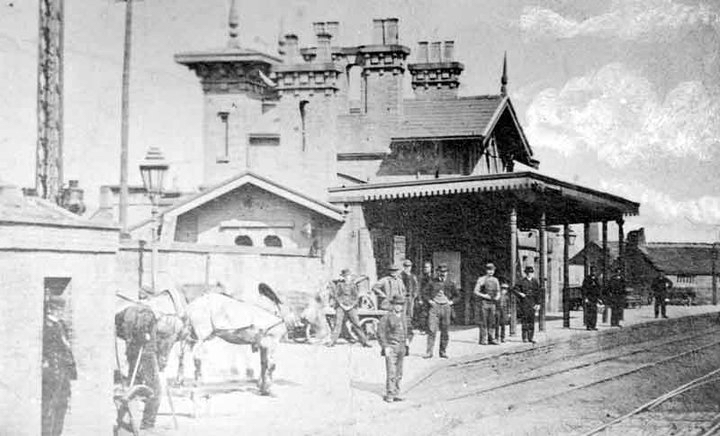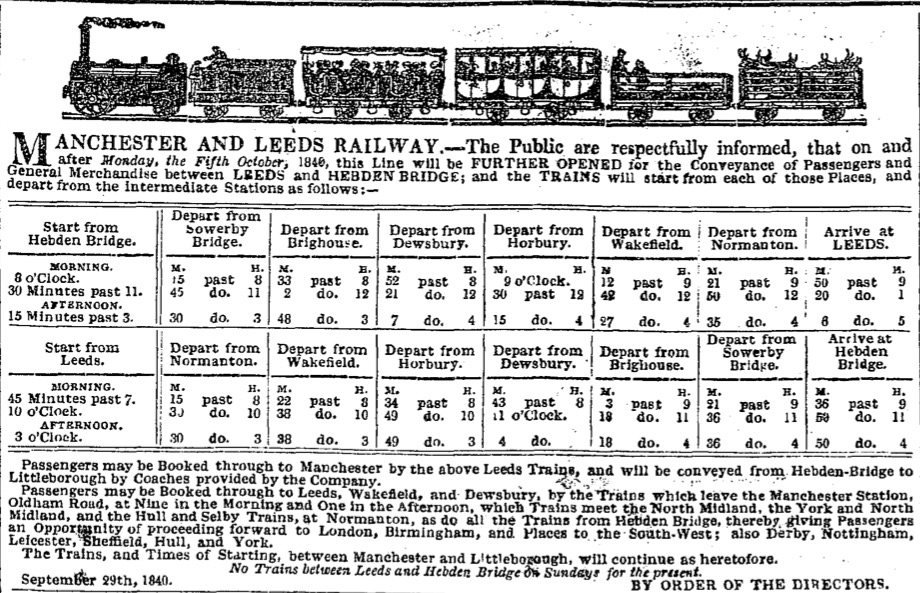1840 - the railway comes to Rastrick
The railway station sign will tell you that you have arrived at Brighouse but for almost 180 years, the good people of Rastrick have told people that Brighouse doesn’t have a station, it is in Rastrick.

The first Brighouse railway station, situated on the south side of the Calder and therefore in Rastrick.
The line through Brighouse officially opened on Monday, 5th October 1840. On the first train through the town was a newspaper reporter from the Leeds Mercury who published his report in the October 10th edition. Below is an abbreviated version of that report.
On Monday last, pursuant to public notice, this great and important line of Railway was opened for the conveyance of passengers from Leeds to Hebden Bridge – thus completing, with the exception of nine miles, the entire distance between Leeds and Manchester. Of this distance ten miles, from Leeds to Normanton, are upon the line of the North Midland Railway; twenty-seven miles, from Normanton to Hebden Bridge, have now for the first time opened; and thirteen miles from Manchester to Littleborough were opened in July of last year. The nine miles yet unfinished are between Hebden Bridge and Littleborough and include the Summit Tunnel, in the latter of which the works have been so long at a stand owing to the slipping of the earth. It is confidently anticipated that this distance of nine miles, the final link in the chain, will be ready for opening in the first week of December, when trains will pass uninterruptedly from Leeds to Manchester.

We speak on the highest authority when we say, that this Railway is the greatest triumph of engineering science over the obstacles interposed by nature, presented in any railway in the kingdom. The high chain of hills which separates the counties of York and Lancaster is only intersected by one valley, namely, the valley of the Calder, and that so narrow and winding, so lined with towns and villages, and so preoccupied by the turnpike road, the river and the canal, as to make it exceedingly difficult to carry a railway through it. Yet, by embankments and cuttings, by removing rocks and building up arches, by occasionally diverting the river and the road and often crossing both, by piercing the hills with short tunnels and taking first time of the valley and then the other, a line has been constructed not only capable of being worked by locomotive engines, but of being easily and advantageously worked. There are no objectionable curves, and there is not one gradient having half the inclination of the worst on the Liverpool and Manchester Railway. The line is somewhat circuitous, and this is its only disadvantage, a disadvantage which the speed of locomotive travelling reduces to insignificance. But the railway passes in its entire length through a country as remarkable for its dense population and active industry as for its romantic beauty.
The engineer by whom the line was planned, and under whose superintendence it has been executed, is the celebrated George Stephenson, whose genius and unparalleled works we have so often had occasion to notice with high admiration.
Near Mirfield the two lines are laid down, and the work is complete. Here the railway passes through the valley by an embankment, and crosses the river twice, once by a fine skew bridge, and again by a viaduct of thirteen arches of about 45 feet span each; the latter, which is a very fine structure, crosses the river obliquely in a wide part near several mills, and also crosses the road from Mirfield to Hopton. The scenery in this part, where the hills rise to a great elevation and are richly clothed with wood, is exceedingly beautiful. A station will be erected at this place. The population came out to gaze at the spectacle, and flags were flying in honour of the event.
Ground was first broken on the 18th August 1837; the first portion, measuring thirteen miles from Manchester to Littleborough, was opened on the 3rd July 1839 and has been worked with great success; and the entire line will be completed early in December of the present year, within about three years and a quarter from its commencement. The length of the railway from Manchester to its junction with the North Midland at Normanton is fifty miles; and as Normanton is ten miles from Leeds, the entire distance from Leeds to Manchester by railway is sixty miles.
The opening of the portion of the line from Hebden Bridge to Normanton, which took place on Monday, was not attended with any ceremonial. The directors came from Manchester to Hebden Bridge, went by railway to Leeds, and returned the same day, but without any kind of display. But this did not prevent a very great concourse of spectators at every town, village and hamlet on the line: at many of these places flags were flying: and the inhabitants, old and young, and of both sexes, poured forthwith to witness, for the first time, the interesting sight of railway travelling through the valley of the Calder. Considerable danger arose at some points from the eagerness of the multitudes to travel by the carriages on the first day: and it is a happy circumstance that the day passed over without any accidents.

It was 48 minutes past nine when we crossed the Leeds and Huddersfield road at Cooper bridge, 24 miles from Leeds. Here, we find, there will be a station for the accommodation of Huddersfield, on the North of the turnpike road; and from this point, we presume, there will ere long be a railway constructed to that important town, – the distance being about four miles along a valley which presents every facility for the economical construction of such a line. At present, however, the station for Huddersfield is at Brighouse. Pursuing our course up the valley, the fine woods of Kirklees park, (Sir George Armytage’s) and the grave of the renowned Robin Hood on our right, the railway again crosses the Calder twice by stone viaducts, each consisting of two arches of 76 feet span. It then enters Bradley Wood, on the south-west side of the valley, where there is a deep cutting, and, issuing from it in a part where the valley bursts upon the traveller with a noble landscape, runs for a mile nearly on the surface to Brighouse.
Near this place we saw the fires where the Low Moor coal is in course of being reduced to coke by Mr. walker, a tenant of Sir Geo. Armytage’s. This is the best coke in the kingdom for the use of locomotive engines, and the Manchester and Leeds Company have entered into contract with Mr. walker, who is to supply 50 tons a day for five years at the rate of 14s per ton. The cheapness and excellence of the coke are of great importance to this railway, as will be seen when we state that the Liverpool and Manchester Company have until lately paid 25s per ton, and are now paying 23s per ton for their coke, and the London and Birmingham Company pay two guineas per ton. Some coke is of a quality to form clinkers on the bars of the furnace and destroy the bars; but the Low Moor coke has not this bad property.
We reached Brighouse station, which is 26 miles from Leeds and 34 from Manchester, at four minutes before ten o’clock. This is a very important station, not only from the great population and flourishing trade of the contiguous places, Brighouse and Rastrick, and the neighbouring villages of Clifton, &c. but from its being at present the station for Huddersfield, distant three miles and a half, and also from Bradford, distant seven miles. The station house is tastefully constructed, somewhat in the Chinese style. Here the crowd was exceedingly great; and many persons having paid for places, who could not be accommodated in the carriages, they mounted on the top of the carriages and sat there, not in a very safe position. The Huddersfield coach or omnibus was awaiting the arrival of the train.
After a stoppage of eight minutes, we moved forward at four minutes past ten. Skirting Rastrick on our left, with the river on the right, we passed over a viaduct of six stone arches, 46 feet span each. Running up the valley the railway enters Strangstry Wood, which, from the precipitous nature of the ground and close proximity to the river, has not been passed without considerable difficulty. By means of high retaining walls and several arches, however, the railway has been very securely formed; and what was once a steep and rugged wood rising almost perpendicularly from the river, presents now a smooth and even surface, over which the rails are laid in gentle and uniform curves. The valley here winds very graciously, alternatively opening and contracting, and lateral valleys run into it between commanding hills luxuriantly clothed with wood; whilst the river, still more serpentine than the valley, sweeps from side to side through beautiful meadows. Up one of the branching valleys, and at a considerable elevation, is seen the church of Southowram. Elland now comes into view, as well as the high hills about Stainland and those of the Blackstone-edge range. The train then continued to Hebden Bridge from here.